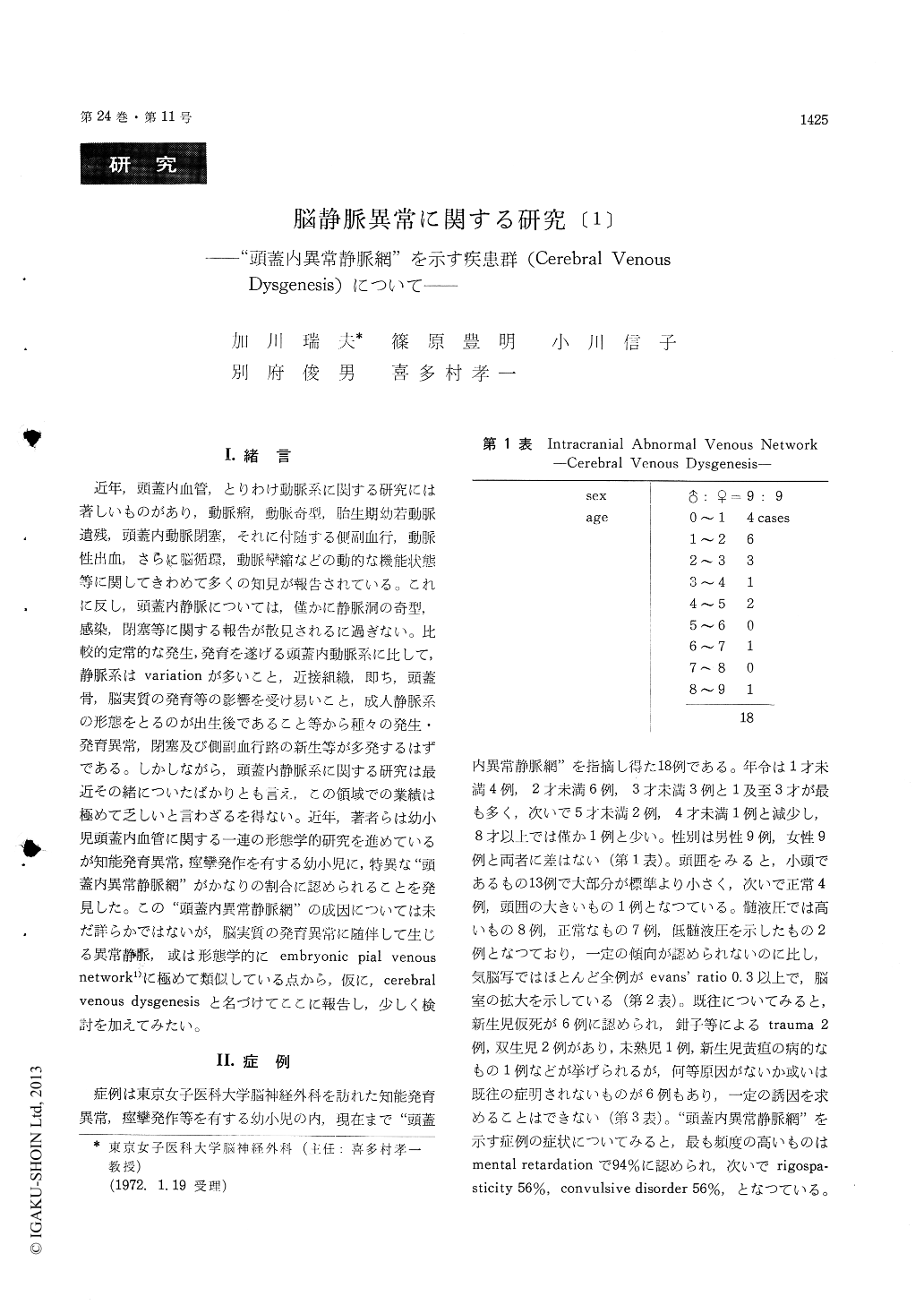Japanese
English
- 有料閲覧
- Abstract 文献概要
- 1ページ目 Look Inside
I.緒言
近年,頭蓋内血管,とりわけ動脈系に関する研究には著しいものがあり,動脈瘤,動脈奇型,胎生期幼若動脈遺残,頭蓋内動脈閉塞,それに付随する側副血行,動脈性出血,さらに脳循環,動脈攣縮などの動的な機能状態等に関してきわめて多くの知見が報告されている。これに反し,頭蓋内静脈については,僅かに静脈洞の奇型,感染,閉塞等に関する報告が散見されるに過ぎない。比較的定常的な発生,発育を遂げる頭蓋内動脈系に比して,静脈系はvariationが多いこと,近接組織,即ち,頭蓋骨,脳実質の発育等の影響を受け易いこと,成人静脈系の形態をとるのが出生後であること等から種々の発生・発育異常,閉塞及び側副血行路の新生等が多発するはずである。しかしながら,頭蓋内静脈系に関する研究は最近その緒についたばかりとも言え,この領域での業績は極めて乏しいと言わざるを得ない。近年,著者らは幼小児頭蓋内血管に関する一連の形態学的研究を進めているが知能発育異常,痙攣発作を有する幼小児に,特異な"頭蓋内異常静脈網"がかなりの割合に認められることを発見した。この"頭蓋内異常静脈網"の成因については未だ詳らかではないが,脳実質の発育異常に随伴して生じる異常静脈,或は形態学的にembryonic pial venousnetwork1)に極めて類似している点から,仮に,cerebralvenous dysgenesisと名づけてここに報告し,少しく検討を加えてみたい。
In this paper, we intended to clarify a cerebral vascular disorder due to pathological venous vas-culature, 18 cases with abnormal cortical venous network were presented and the pathogenesis of this disease was discussed.
Clinical manifestations of this disease are mental retardation, rigospasticity, convulsive disorder and amaurosis. The disease occurs in young decade, especially in children under 8 years of age. No sex predominance is noted.
Angiografic findings of this disease are extremely characteristic, they are, early venous filling with fine capillary stain at subcortex, marked venous network of the cortex, and nonvisualization of deep vein, especially basal vein. This cortical venous abnormal network consists of fine spiral, tortuous venule, which drain into abnormal anastomotic vein or bridging vein of the cortex. Numerous pathol-ogical anastomosis between those abnormal vein and venules is elicited.
Venous sinus occlusion has not been shown. As for as morphological study are concerned, these abnormal cortical venous network is quite different from co-lateral circulation in venous occlusion or venous occlusive disease. We call this pathological venous network as "Cerebral venous dysgenesis" tentatively.
The following pathogenesis should be considered.
1) Capillary angiomatous malformation, persistent of embryonic venous network, due to develo- pemental disturbance of the brain.
2) Agenesis or occlusive disease of deep cerebral vein.
3) Reactive proliferation of venous channels due to subdural effusion, or infection at perinatal period.
The pathogenesis of this disease has not been clarified yet, and further angiographic and clinico-pathologial survey should be required.

Copyright © 1972, Igaku-Shoin Ltd. All rights reserved.


